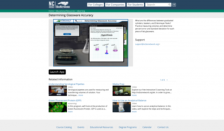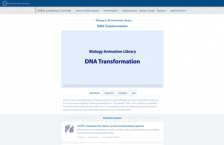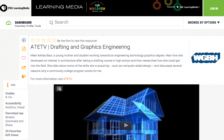Browse Resources
Application -- Flash
Resources |
|---|
The North Carolina Community College System BioNetwork's interactive eLearning tools (IETs) are reusable chunks of training that can be deployed in a variety of courses or training programs. IETs are designed to enhance, not replace hands-on training. Learners are able to enter a hands-on lab...
This brief interactive activity, by the Electromechanical Digital Library and Wisconsin Technical College System faculty, introduces digital circuit devices, their applications as decision or memory devices, and asks three review questions. This is an excellent resource, as are the others in the...
This interactive presentation, created by James Bourassa and John Rosz for the Electromechanical Digital Library, discusses displacement and velocity ratios. Bourassa and Rosz begin by providing detailed definitions of both topics and then provide mathematical examples of each. Once this basic...
This animation from Cold Spring Harbor Laboratory's Dolan DNA Learning Center presents DNA arrays. The animation contains information on Pat Brown's discovery and the purpose of DNA arrays to study gene expression as well as its role in the development of pharmacogenomic treatment for diseases such...
The Using DNA Barcodes to Identify and Classify Living Things laboratory demonstrates several important concepts of modern biology. During the course of this laboratory, students will collect and analyze sequence data from plants or animals or products from them, use DNA sequences to identify...
The discovery of enzymes that could cut and paste DNA made genetic engineering possible. Restriction enzymes, found naturally in bacteria, can be used to cut DNA fragment at specific sequences, while another enzyme, DNA ligase, can attach or rejoin DNA fragments with complementary ends. This...
Stanley Cohen and Herbert Boyer's historic experiment used techniques to cut and paste DNA to create the first custom-made organism containing recombined or 'recombinant' DNA. Cohen and Boyer inserted the recombinant DNA molecule they created into E. coli bacteria by means of a plasmid, thereby...
DNA transformation is a naturally occurring but rare event in which DNA can be transferred into bacteria. In 1970, Morton Mandel and Akiko Higa discovered a way to make E. coli more 'competent' for transforming foreign DNA. Their calcium chloride method is widely used today to obtain high-efficiency...
This resource, provided by Maricopa Advanced Technology Education Center (MATEC), is a cut-away animation of a pneumatic double action gripper. The objective of the animation is to describe how the double action gripper works. A short description is included. An .mp4 is also available and runs 01:15...
This video segment, adapted from ATETV, explores Engineering Technology by providing an overview of what skills students will need to learn in order to succeed after graduation. This specific video takes a look at an adult non-traditional student returning to school, and how the community college...
|
| ← PreviousNext → |









